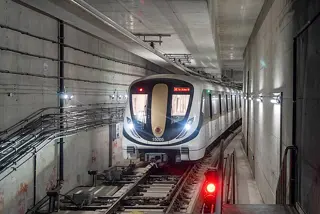Surat Metro Boom: Transforming Suburban Property Markets
 Surat’s rapid transit expansion is causing a big change in real estate dynamics, with metro corridors becoming key investment zones. The Surat Metro Rail Project, with 57.20% of Phase 1 already complete, promises to change urban mobility and property values. Here, we look at key metro hotspots and their impact on residential and commercial demand.
Surat’s rapid transit expansion is causing a big change in real estate dynamics, with metro corridors becoming key investment zones. The Surat Metro Rail Project, with 57.20% of Phase 1 already complete, promises to change urban mobility and property values. Here, we look at key metro hotspots and their impact on residential and commercial demand.
Red Line: The West-East Connector
The Red Line, spanning 21.61 km, connects Sarthana to Dream City with both elevated and underground sections. Important stations boosting property demand include:
| Station | Key Features | Expected Impact |
|---|---|---|
| Sarthana | Western entry point with future mixed-use hubs | Expansion of affordable housing |
| Surat Railway Station | Integration with Indian Railways | Commercial hubs near stations |
| Dream City | Convention centers in business districts | Office space demand for MNCs |
The Sarthana station area is seeing land consolidation for mid-budget apartments. Dream City’s convention centers are drawing shared office spaces for startups.
Green Line: The North-South Axis
The 18.74 km elevated Green Line links Bhesan Depot to Saroli, focusing on industrial and logistics zones. Important nodes include:
1. Bhesan Depot: Development centered around logistics with warehouse conversions 2. Mithikhadi: Close to industrial estates, creating demand for worker-centric housing 3. Saroli: Last-mile connectivity to Mumbai-Delhi Industrial Corridor ventures
This corridor is changing Surat’s industrial real estate, with Gujarat Metro Rail Corporation (GMRC)-driven FSI relaxations increasing plot values by 8–12% in traction zones.
Metro-Driven Demand Shifts
Residential Focus:
- Priority Areas: Nana Varaccha, Althan Gam, and VIP Road see rising enquiries for 1–2BHK flats
- Price Trends: Pre-launch inventory along metro routes commands 15–20% premiums compared to off-corridor properties
- Developer Strategy: Mixed-use projects with co-living spaces and retail podiums dominate new launches
Commercial Surge:
- Office Spaces: Increased demand for grade-A office spaces near interchange stations like Majura Gate and Exhibition Centre
- Leasing Activity: Q2 2025 data shows a 25% rise in enquiries for metro-adjacent business parks with transit access
- REITS Listing: Possibility of transit-linked commercial REITs capturing investment trust
Economic Multipliers
The ₹30,325 crore urban development budget boost ensures accelerated infrastructure buildouts, creating secondary benefits including:
- Employment Clusters: Metro-dependent jobs boost housing demand for rent or buy
- Retail Revival: Station subtree business centers now prioritize F&B and service retail formats
- Empowerment Zones: Women-centric housing projects sprouting near ITI and training institute areas
Future Outlook
With full Phase 1 completion by 2027, the metro network will connect 40.35 km of urban expanse, potentially triggering further expansions to neighboring corridors. As Asian Development Bank-funded projects advance, Surat’s property landscape continues evolving toward transit-oriented living and business models.